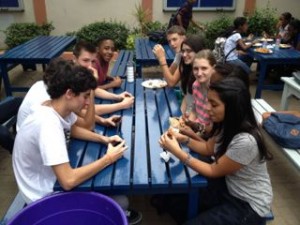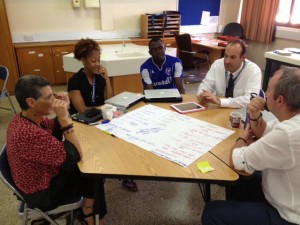Over the years one collects various expressions, articles, and handouts that are timeless for their value. The print may fade over the years but their place on my bulletin board above my desk remains. One such article/handout has been with me for about 10 years, always on my bulletin board. The “Ten Tasks of Adolescense” is a great reminder of the challenges middle and high school kids face on a daily basis. Just as a parent watches the growth of their own child over the years, teachers gain levels of satisfaction in watching the development of their students over time. When you think of the challenges that kids face in

Building Relationships over Lunch!!
navigating day to day, week to week, year to year experiences as their minds and bodies are changing so rapidly, the role of schools and of teachers becomes so special. To be a great teacher, you must be tuned into these adolescent tasks. To be a great teacher you must be focused upon the relationships you are nurturing with students. Adolescent life is full of challenge and opportunity, great teachers maximize both.
Have a read of the 10 Tasks of Adolescents. At the bottom is an interesting extract focusing upon the importance of relationships between adults and students in schools.
The Ten Tasks of Adolescence
From Raising Teens, A Synthesis of Research and a Foundation for Action, a. Rae Simpson, Harvard School of Public Health
| Adjust to sexually maturing bodies and feelings |
Teens are faced with adjusting to bodies that as much as double in size and that acquire sexual characteristics, as well as learning to manage the accompanying biological changes and sexual feelings and to engage in healthy sexual behaviors. Their task also includes establishing sexual identity and developing the skills for romantic relationships. |
| Develop and apply abstract thinking skills. |
Teens typically undergo profound changes in their way of thinking during adolescence, allowing them more effectively to understand and coordinate abstract ideas, to think about possibilities, to try out hypotheses, to think ahead, to think about thinking, and to construct philosophies. |
| Develop and apply a more complex level of perspective taking. |
Teens typically acquire a powerful new ability to understand human relationships in which, having learned to “put themselves in another person’s shoes, they learn to take into account both their perspective and another person’s at the same time, and to use this new ability in resolving problems and conflicts in relationships. |
| Develop and apply new coping skills in areas such as decision making, problem solving, and conflict resolution. |
Related to all these dramatic shifts, teens are involved in acquiring new abilities to think about and plan for the future, to engage in more sophisticated strategies for decision making, problem solving, and conflict resolution, and to moderate their risk taking to serve goals rather than jeopardize them. |
| Identify meaningful moral standards, values, and belief systems. |
Building on these changes and resulting skills, teens typically develop a more complex understanding of moral behavior and underlying principles of justice and care, questioning beliefs from childhood and adopting more personally meaningful values, religious views, and belief systems to guide their decisions and behavior. |
| Understand and express more complex emotional experiences. |
Also related to these changes are shifts for teens toward an ability to identify and communicate more complex emotions, to understand the emotions of others in more sophisticated ways, and to think about emotions in abstract ways. |
| Form friendships that are mutually close and supportive |
Although youngsters typically have friends throughout childhood, teens generally develop peer relationships that play much more powerful roles in providing support and connection in their lives. They tend to shift from friendships based largely on the sharing of interests and activities to those based on the sharing of ideas and feelings, with the development of mutual trust and understanding. |
| Establish key aspects of identity |
Identity formation is in a sense a lifelong process, but crucial aspects of identity are typically forged at adolescence, including developing an identity that reflects a sense of individuality as well as connection to valued people and groups. Another part of this task is developing a positive identity around gender, physical attributes, sexuality, and ethnicity, and as well sensitivity to the diversity of groups that make up society. |
| Meet the demands of increasingly mature roles and responsibilities |
Teens gradually take on the roles that will be expected of them in adulthood, learning to acquire the skills and manage the multiple demands that will allow them to move into the labor market, as well as to meet expectations regarding commitment to family, community, and citizenship. |
| Renegotiate relationships with adults in parenting (and other) roles |
Although the tasks of adolescence has sometimes been described as “separating” from parents and other caregivers, it is more widely seen now as adults and teens working together to negotiate a change in the relationship that accommodates a balance of autonomy and ongoing connection, with the emphasis on each depending in part on the family’s ethnic background. |
The Relationships Gap
Looking closer at students’ perspectives has shown us that strong relationships with teachers are crucial. The quality of teacher relationships seems to be correlated to how much effort students put forth in their school work, and indeed, research indicates that effort is more important than innate ability when it comes to achievement (Dweck, 2006). As both the number of standardized tests and the stakes related to passing them increase, student effort must keep pace.
Our survey results imply that building relationships with students help increase their effort, which is consistent with research showing that the relationships students have with teachers is one of the best predictors of hard work and engagement in school (Osterman, 2000). When comparing responses of students who agreed with the statement, “ I put forth my best effort at school” with those who did not, we saw dramatically different perspectives on student-teacher relationships. Students who said they put forth their best effort were twice as likely as students who said they did not to agree with the statement, “Teachers care about me as a individual.” Similarly, students who said they put forth their best effort were twice as likely to agree that “Teachers respect students.”
Another telling survey finding was that 56 percent of students who reported that they put forth their best effort also said they have a teacher they can talk with if they experience a problem, whereas only 32 percent of the students who did not put forth their best effort agreed with this statement.
Some survey results indicated that many students lack a solid, trusting relationship with a teacher. For example, only 45 percent of students surveyed agreed that “Teachers care if I am absent from school.” How is it that more than half of the almost 500,000 students surveyed do not believe teachers care if they show up? Teachers must work harder to develop relationships with students and change these kinds of perceptions. Doing so will foster students’ connectedness at school — an undeniable catalyst for increasing students’ investment in learning.
Schools can — and should — implement practices that lead to strong teacher-student relationships.
Excerpted from Got Opportunity?
Russell J. Quaglia, Kristine M. Fox and Michael J. Corso; Middleweb, Norton@middleweb.com
 Diploma Program strive to develop internationalism in our students and strengthen their learner profile attributes, our students are sheltered from so many realities of the world. I am worried.
Diploma Program strive to develop internationalism in our students and strengthen their learner profile attributes, our students are sheltered from so many realities of the world. I am worried. compliance with our learners. Is it inevitable? If there is an inevitability about such a culture with students, is the same to be said for teachers as learners? Do we build a system in which the default for adult learners is compliance? If we want kids to become enquirers and creative problem solvers, and independent learners, shouldn’t the same be true for teachers? In reality if teachers aren’t learning, then students aren’t learning.
compliance with our learners. Is it inevitable? If there is an inevitability about such a culture with students, is the same to be said for teachers as learners? Do we build a system in which the default for adult learners is compliance? If we want kids to become enquirers and creative problem solvers, and independent learners, shouldn’t the same be true for teachers? In reality if teachers aren’t learning, then students aren’t learning.
